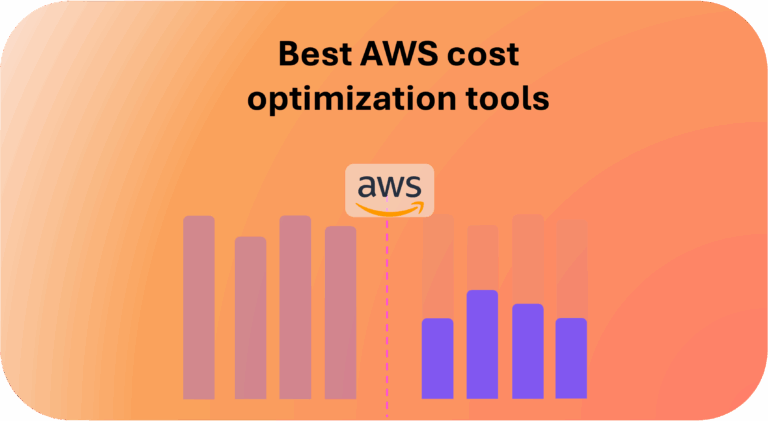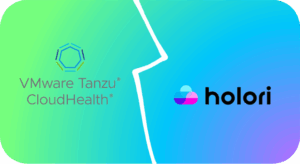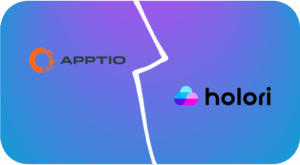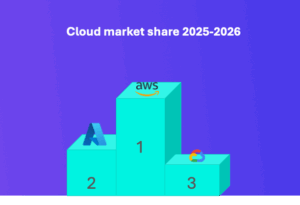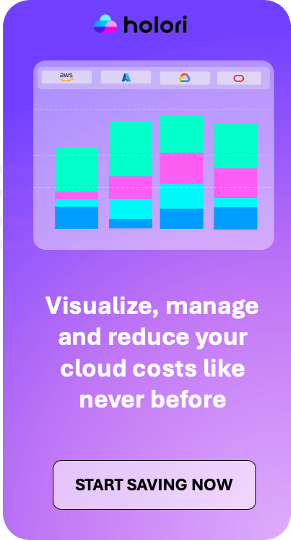With AWS generating over $100 billion in revenue in 2024, it’s clear that cloud spending is massive—and full of opportunities for optimization. But for many organizations, that spend is anything but efficient. Keeping AWS costs under control isn’t just about cutting expenses; it’s about making cloud usage predictable, accountable, and aligned with business goals. As AWS environments scale, so do the challenges of tracking usage, eliminating waste, and optimizing spend across services and teams. The good news? A growing ecosystem of cost optimization tools is rising to meet these challenges, giving FinOps teams the visibility and control they need to turn cloud chaos into financial clarity.
At Holori, we’ve helped hundreds of organizations optimize their AWS spending through our comprehensive FinOps platform. As AWS cost optimization experts, we’ve developed this guide to compare the most effective tools available in 2025, including our own Holori Cloud Cost Management solution, to help you make informed decisions about your cloud cost management strategy.
Understanding AWS Cost Optimization: Why It Matters
AWS cost optimization is the systematic process of reducing Amazon Web Services expenses while maintaining or improving performance and functionality. When implemented effectively, cost optimization strategies can significantly impact your bottom line by:
- Preventing unexpected cost spikes from auto-scaling and pay-as-you-go pricing models
- Eliminating waste from idle resources and over-provisioned infrastructure
- Providing engineering teams with actionable cost insights for architecture decisions
- Enabling finance teams to accurately track and allocate cloud spending
- Freeing up budget for innovation and growth initiatives
According to our client data at Holori, organizations implementing comprehensive cost optimization strategies typically reduce their cloud spend by 25-40%, representing substantial savings that can be reinvested in business priorities.
Key Areas for AWS Cost Optimization

Before diving into specific tools, it’s important to understand the major areas where optimization can yield the greatest impact:
1. Cost Visibility and Allocation
Complete visibility across your AWS environment is the foundation of effective cost management. This includes:
- Cost attribution: Properly allocating shared resources to specific departments, projects, or applications
- Tagging strategies: Implementing consistent tagging to track resource ownership and purpose
- Reporting and showbacks: Creating transparent cost reporting across business units
2. Resource Optimization
Ensuring cloud resources match actual requirements involves:
- Right-sizing: Adjusting instance types and resources to match actual utilization needs
- Scheduling: Automatically turning off non-production resources during inactive periods
- Storage optimization: Moving data to appropriate storage tiers based on access patterns
3. Discount Management
AWS offers various discount mechanisms that require strategic management:
- Reserved Instances: Pre-purchasing capacity commitments for predictable workloads
- Savings Plans: Flexible usage commitments across multiple services
- Spot Instances: Utilizing excess AWS capacity at steep discounts (70-90%)
4. Architecture Optimization
Sometimes, the most significant savings come from rethinking architecture:
- Serverless adoption: Shifting appropriate workloads to pay-per-use models
- Container optimization: Improving container density and resource utilization
- Multi-account strategies: Organizing resources for optimal discount application
AWS Native Tools vs. Third-Party Solutions: Making the Right Choice
When approaching AWS cost optimization, one of the first decisions organizations face is whether to rely on AWS’s native tooling or invest in third-party solutions like Holori. Understanding the advantages and limitations of each approach is crucial for making the right choice for your organization.
Native AWS Cost Tools vs Third-Party Tools Comparison
| Category | Native AWS Tools | Third-Party Tools (e.g., Holori) |
|---|---|---|
| Integration | Fully integrated with AWS Console; no external setup needed | Requires connecting cloud accounts; typically one-time setup with read-only permissions |
| Coverage | AWS services only | Broader coverage—multi-cloud, Kubernetes, specialized services (Lambda, S3), and third-party tools |
| Cost to Use | Included with AWS subscription (some advanced features may have minimal costs) | Paid subscription; typically based on percentage of cloud spend or tiered pricing model |
| Depth of Analysis | Basic utilization metrics and fundamental recommendations | Advanced analytics with ML-driven insights, anomaly detection, and business context |
| Automation | Limited automation capabilities; mostly manual implementation | Extensive automation for commitment management, right-sizing, and resource scheduling |
| User Experience | Fragmented across multiple AWS console sections | Purpose-built interfaces designed specifically for cost management workflows |
| Support | Standard AWS support channels | Specialized cost optimization expertise and implementation guidance |
| FinOps Alignment | Basic cost allocation | Comprehensive FinOps framework support with accountability and optimization |
| Time-to-Value | Immediate access but requires expertise to extract value | Slightly longer setup but faster ROI with guided implementation |
| Ideal For | Organizations with small AWS footprints (<$10K/month) and basic needs | Growing organizations seeking deeper savings, automation, and cross-team collaboration |
12 Best AWS Cost Optimization Tools
Let’s examine the leading tools in the market across different categories, including our own Holori platform:
1- Holori Cloud Cost Management Platform
Holori is a modern FinOps platform that unifies cloud cost management and infrastructure visibility across providers like AWS, Azure, GCP, and Scaleway. It consolidates multi-cloud expenses into a single, filterable dashboard, allowing teams to allocate costs by project, team, or provider using virtual tags. Holori automatically generates infrastructure diagrams on a daily or weekly basis, offering a clear visual map of cloud assets and their configurations. Its built-in optimization engine provides actionable insights to eliminate waste, rightsize resources, and take advantage of pricing commitments. With virtual tagging, users can maintain consistent cost tracking without relying on native provider tags. The platform also includes tools to plan future deployments and forecast cloud costs before launching projects. Fast to deploy and easy to use, Holori enables organizations to gain financial and technical control over their cloud environment in minutes.
AWS Cost Optimization Native Tools
2. AWS Cost Explorer
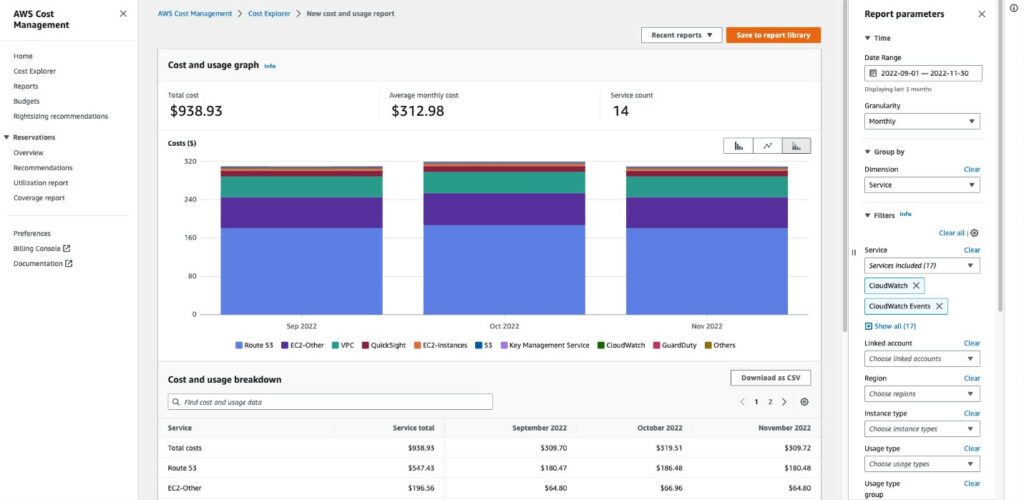
AWS Cost Explorer provides fundamental visualization and analysis of up to 13 months of historical cost data with the ability to generate cost forecasts for the next year and filter expenses by various dimensions like service, account, or tag. As a native AWS tool, it’s included with your AWS subscription and requires no additional investment, making it ideal for organizations seeking basic built-in cost analysis. However, Cost Explorer offers limited automation capabilities and less granular insights compared to specialized tools, functioning primarily as a reporting tool rather than a proactive optimization solution.
3. AWS Budgets
AWS Budgets enables teams to set custom budgets with configurable thresholds, receiving alerts when costs exceed or are forecasted to exceed predefined limits across various dimensions including tags and accounts. The service allows for automated actions when thresholds are reached, providing a simple budget tracking and notification capability within the AWS ecosystem. As a native AWS tool, it’s readily available but functions more reactively than proactively, with limited predictive analytics capabilities to prevent budget overruns before they occur. AWS Budgets works best for teams needing straightforward budget monitoring rather than comprehensive cost optimization.
4. AWS Trusted Advisor
AWS Trusted Advisor provides automated recommendations across multiple categories, identifying underutilized resources and highlighting EC2 Reserved Instance optimization opportunities alongside security and performance best practices. The service offers general AWS environment optimization recommendations that extend beyond just cost considerations, making it valuable for holistic environment management. However, Trusted Advisor’s recommendations tend to be general in nature and often require additional analysis to implement effectively, lacking the actionable prioritization and implementation guidance found in specialized platforms. The service is most suitable for organizations seeking broad advisory insights rather than deep cost optimization capabilities.
Comprehensive best AWS Cost Optimization tools
5. Apptio Cloudability
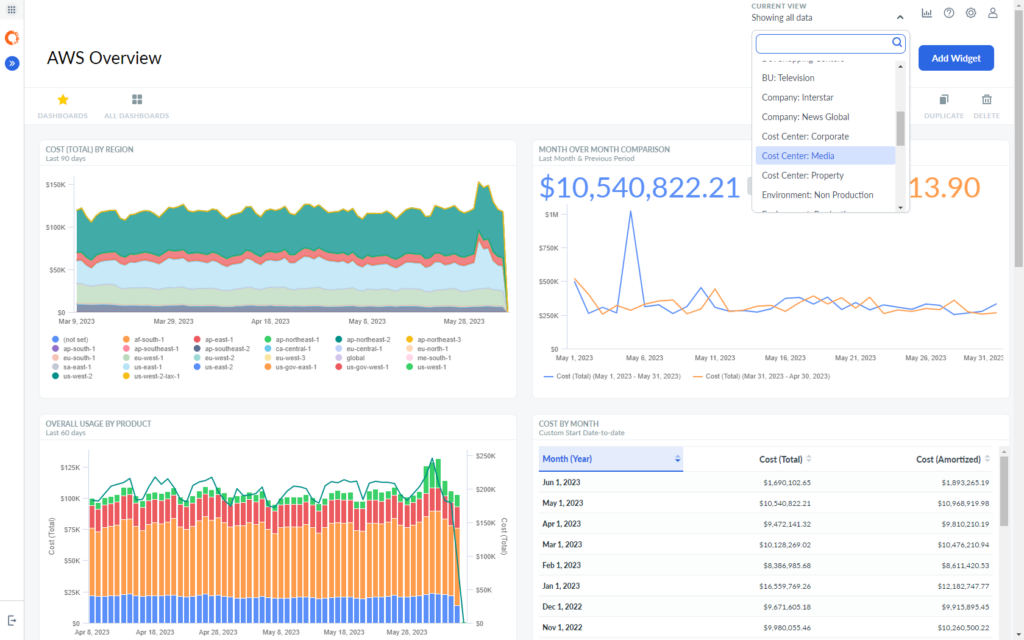
Apptio cloudability delivers detailed cost allocation and chargeback capabilities with robust commitment management for Reserved Instances and Savings Plans, alongside advanced forecasting and budget tracking features designed for enterprise environments. The platform demonstrates a strong FinOps focus with extensive reporting capabilities and mature, well-established methodologies for cloud financial management. While powerful, Cloudability comes with a higher price point and can require significant configuration effort to extract maximum value, creating a steeper implementation curve. The solution excels in enterprise organizations with complex multi-account structures seeking comprehensive financial management but may be excessive for smaller deployments.
6. CloudHealth (Broadcom)

CloudHealth offers multi-cloud cost management across AWS, Azure, and GCP with policy-driven automation for governance and optimization, including right-sizing recommendations that analyze performance impact. The platform provides commitment management capabilities and extensive API integrations, making it particularly valuable for organizations running hybrid or multi-cloud environments. Despite these strengths, CloudHealth presents a complex interface with a steep learning curve and focuses more on reporting than automation, requiring dedicated resources to manage effectively. Organizations with diverse cloud providers will benefit most from CloudHealth’s unified management approach, though they should be prepared for longer implementation timelines.
7. Vantage
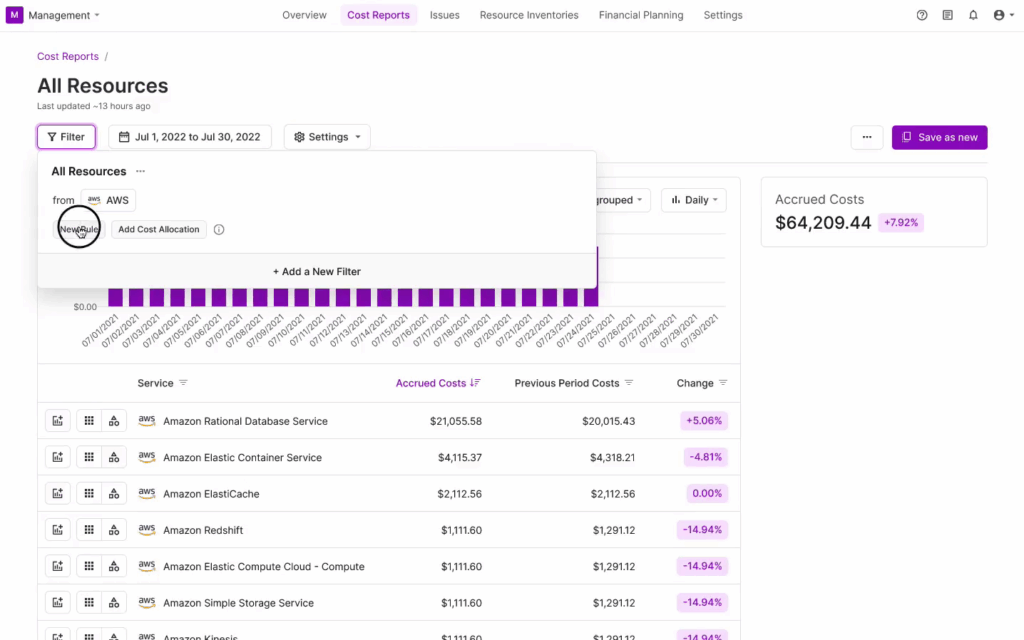
Vantage.sh provides a developer-friendly cloud cost management platform with an intuitive interface that makes complex AWS billing data immediately accessible and actionable for engineering teams. The platform excels at creating custom cost reporting dashboards with automated anomaly detection that alerts teams to unexpected spending changes before they become significant problems. Vantage.sh offers multi-cloud support across AWS, GCP, and Azure with native Kubernetes cost visibility, but distinguishes itself with a pricing model that scales with usage without percentage-based fees that increase as cloud spending grows. While lacking some of the advanced automation features of enterprise solutions, Vantage delivers exceptional value for engineering organizations seeking cost transparency with minimal setup overhead and has become particularly popular among startups and growth-stage companies looking for straightforward cost management without complex implementation requirements.
Specialized Best AWS cost Optimization Tools
8. nOps
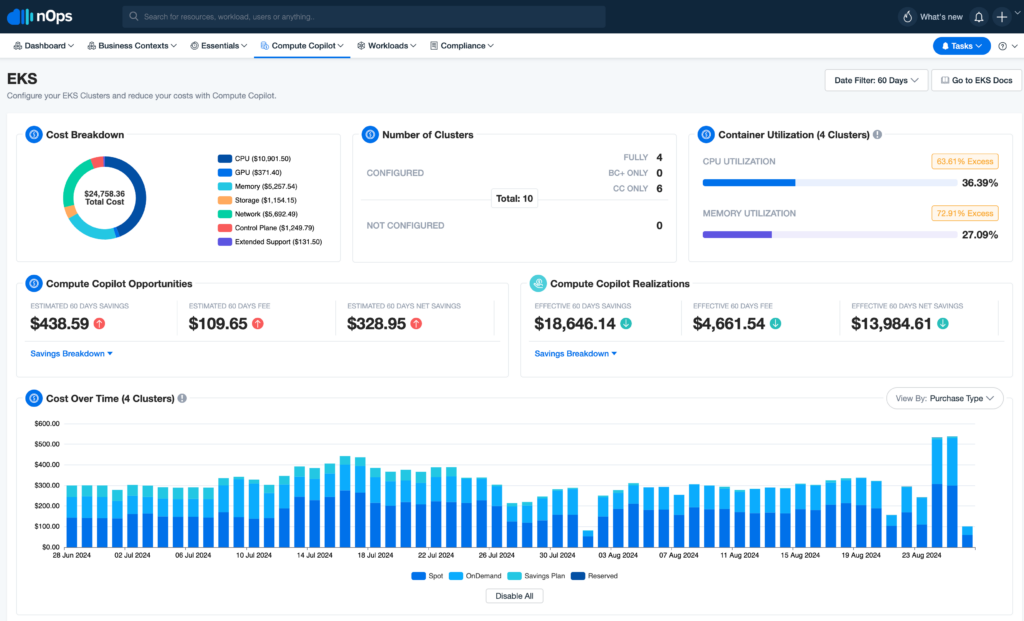
nOps delivers ML-powered compute resource optimization with automated Spot instance management that includes reliability safeguards to prevent workload disruption. The platform provides automated lifecycle management for commitment discounts alongside business context mapping for complete cost allocation, taking an automation-first approach to optimization. While excelling in AWS environments, nOps offers less comprehensive coverage for other cloud providers compared to some multi-cloud alternatives, limiting its utility in hybrid deployments. The solution works best for growing organizations that prioritize reducing manual optimization efforts while maintaining strong technical controls over cloud resources.
9. Spot by Flexera
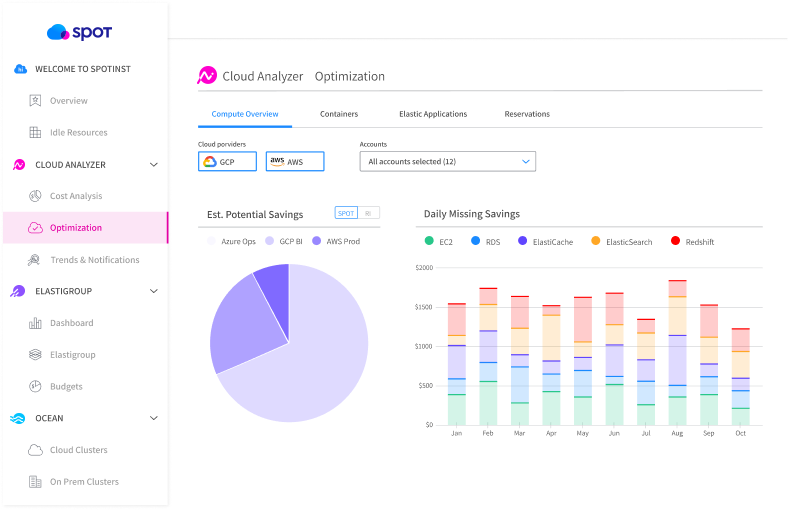
Spot by Flexera provides advanced Spot Instance automation and management that continuously rebalances workloads based on availability and pricing to maximize savings while maintaining reliability. The platform includes container-aware optimization specifically designed for Kubernetes environments alongside commitment management capabilities for predictable workloads. While excelling in compute optimization, particularly for Spot instances, the solution offers less comprehensive coverage of broader cost management concerns beyond compute resources. Organizations seeking to maximize Spot Instance usage while maintaining application reliability will find Spot by NetApp’s sophisticated algorithms particularly valuable, especially in container-heavy environments.
10. ProsperOps

ProsperOps delivers fully automated commitment management for Reserved Instances and Savings Plans using a risk-managed portfolio approach to commitment purchases that minimizes financial exposure. The platform continuously optimizes commitments based on changing usage patterns and provides detailed financial risk analysis with clear recommendations. Though highly effective, ProsperOps maintains a narrower focus compared to comprehensive platforms, primarily concentrating on commitment management rather than broader optimization strategies. The solution works best for organizations seeking to maximize commitment-based discounts with minimal effort who are willing to complement it with other tools for non-commitment optimization areas.
Container and Kubernetes Cost Management
11. Cast.AI
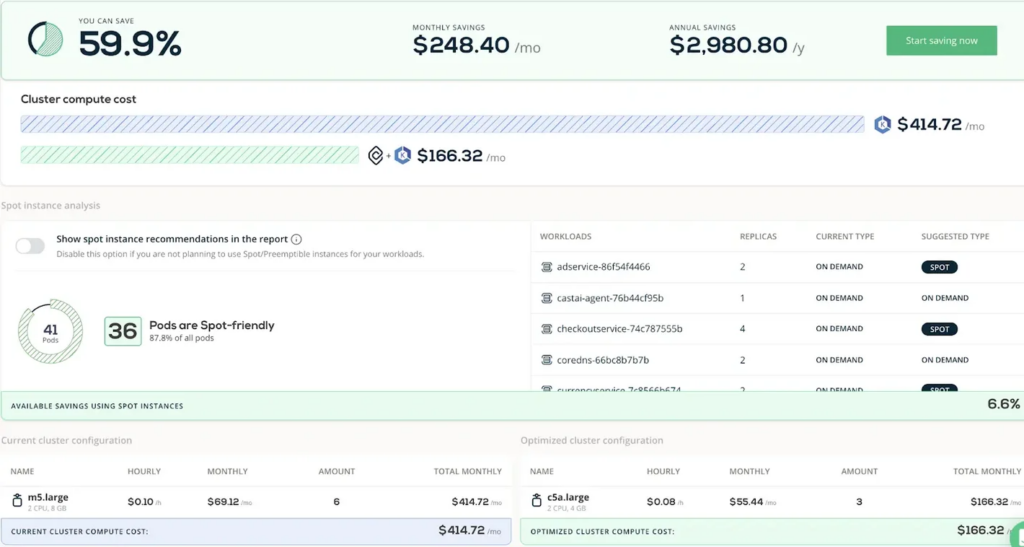
CAST AI delivers automated Kubernetes cost optimization through intelligent node selection and cluster autoscaling that continuously adjusts resources based on actual application needs. The platform automatically identifies the most cost-effective instance types across availability zones while maintaining performance requirements, and implements pod resource right-sizing using machine learning to eliminate waste from over-provisioned containers. CAST AI stands out with its hands-off automation approach that requires minimal configuration, though this automation-first philosophy might concern teams wanting more granular control over specific optimization decisions. Organizations running Kubernetes in production environments can achieve significant savings—typically 50-75% on compute costs—without requiring deep Kubernetes expertise, making CAST AI particularly valuable for teams seeking optimization with minimal operational overhead.
12. Kubecost

Kubecost provides Kubernetes-native cost allocation and visibility that extends to namespace, pod, and service-level cost attribution with remarkable granularity. The platform offers right-sizing recommendations specifically calibrated for container resources and integrates seamlessly with cluster autoscaling for optimization. While exceptionally strong for containerized environments, Kubecost offers limited scope outside of these environments and requires Kubernetes expertise to implement effectively. Organizations heavily invested in container technologies seeking Kubernetes-specific optimization will find Kubecost’s purpose-built approach invaluable, particularly when container costs represent a significant portion of their cloud spending.
Conclusion: Which is the best AWS Cost optimization tools?
Coosing the right AWS cost optimization tool can make the difference between reactive cloud spending and proactive financial control. Whether you need detailed visibility, automated rightsizing, or strategic multi-cloud insights, the tools covered in this guide offer powerful ways to reduce waste and improve efficiency. At Holori, we believe that cost optimization shouldn’t be an afterthought—it should be built into how teams operate in the cloud.
By implementing a comprehensive cost optimization strategy with the appropriate tools, our clients typically reduce their AWS spending by 25-40% while maintaining or improving performance—creating valuable opportunities to reinvest those savings in innovation and growth.
Ready to transform your approach to AWS cost management? Give Holori a try: https://app.holori.com/


